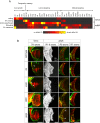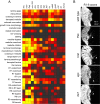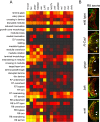Systematic identification of genes that regulate neuronal wiring in the Drosophila visual system
- PMID: 18516287
- PMCID: PMC2377342
- DOI: 10.1371/journal.pgen.1000085
Systematic identification of genes that regulate neuronal wiring in the Drosophila visual system
Abstract
Forward genetic screens in model organisms are an attractive means to identify those genes involved in any complex biological process, including neural circuit assembly. Although mutagenesis screens are readily performed to saturation, gene identification rarely is, being limited by the considerable effort generally required for positional cloning. Here, we apply a systematic positional cloning strategy to identify many of the genes required for neuronal wiring in the Drosophila visual system. From a large-scale forward genetic screen selecting for visual system wiring defects with a normal retinal pattern, we recovered 122 mutations in 42 genetic loci. For 6 of these loci, the underlying genetic lesions were previously identified using traditional methods. Using SNP-based mapping approaches, we have now identified 30 additional genes. Neuronal phenotypes have not previously been reported for 20 of these genes, and no mutant phenotype has been previously described for 5 genes. The genes encode a variety of proteins implicated in cellular processes such as gene regulation, cytoskeletal dynamics, axonal transport, and cell signalling. We conducted a comprehensive phenotypic analysis of 35 genes, scoring wiring defects according to 33 criteria. This work demonstrates the feasibility of combining large-scale gene identification with large-scale mutagenesis in Drosophila, and provides a comprehensive overview of the molecular mechanisms that regulate visual system wiring.
Conflict of interest statement
The authors have declared that no competing interests exist.
Figures





References
-
- Clandinin TR, Zipursky SL. Making connections in the fly visual system. Neuron. 2002;35:827–841. - PubMed
-
- Clandinin TR, Lee CH, Herman T, Lee RC, Yang AY, et al. Drosophila LAR regulates R1-R6 and R7 target specificity in the visual system. Neuron. 2001;32:237–248. - PubMed
-
- Newsome TP, Asling B, Dickson BJ. Analysis of Drosophila photoreceptor axon guidance in eye-specific mosaics. Development. 2000;127:851–860. - PubMed
-
- Martin KA, Poeck B, Roth H, Ebens AJ, Ballard LC, et al. Mutations disrupting neuronal connectivity in the Drosophila visual system. Neuron. 1995;14:229–240. - PubMed
Publication types
MeSH terms
Substances
LinkOut - more resources
Full Text Sources
Molecular Biology Databases
Research Materials

